Snorkeling is done by breathing through a tube while looking down into the water. You can see all sorts of sea creatures and beautiful coral while calmly floating along the surface of the water. It is incredibly simple and enjoyable and that’s what makes it such a popular activity for people of all ages. It’s a healthy way to lose weight, too. The next time you vacation in a tropical destination, you should definitely try snorkeling.
Keep in mind, any water activity introduces the risk of drowning. That said, snorkeling related deaths are extremely uncommon (especially when wearing a flotation device) and there are a few things you should know before jumping headfirst into the water. In this article, we’re going to provide the answers to the question “how does snorkeling work” and give you some pointers to make the experience as enjoyable as possible.
How Does Snorkeling Work?
Snorkeling is sometimes confused with SCUBA diving because SCUBA divers will often wear a snorkel as well. They are not the same thing. SCUBA divers will use the snorkel to conserve oxygen along the surface, however their intention is to dive down.
Next, snorkeling is done solely near the surface of the water and requires only a snorkel and mask (fins are recommended as well). SCUBA diving, on the other hand, requires specific equipment and allows one to go much deeper underwater and remain there for longer compared to snorkeling.
One benefit of snorkeling is how little you need to get started. You don’t need a full body wetsuit, air tank, or regulator like SCUBA divers. Depending on where you are snorkeling, you might want to get a wetsuit or rash guard to keep you warm and protect your skin from harsh UV rays as well as jellyfish stings.
Can Non-Swimmers Safely Snorkel?
Yes, non-swimmers can snorkel as long as they wear a life vest to keep them afloat. How easy or difficult it is depends on the person.
While it isn’t mandatory to know how to swim to snorkel, having swimming experience is highly encouraged. After all, you never know when an equipment malfunction might happen, and wearing a life vest doesn’t prevent you from getting swept away by a swell.
If you do find yourself getting swept away, your natural reaction is to swim directly to shore. Swimming against the current is futile and will only tire you out faster. You should do one of two things.
Either float on your back to conserve energy and wait for the current to subside before swimming back, or swim parallel to the shore until you reach calmer waters, then head back to shore.
Furthermore, non-swimmers may find doing basic tasks in the water to be a chore, such as swimming to where they want to go. Thankfully wearing fins can help make things easier. Additionally, part of snorkeling is also making the occasional dive down to get a closer look at coral or sea creatures.
Non-swimmers are also prone to panicking in the water since they are entirely reliant on a flotation device for their survival. We feel that it would be a very stressful experience and the non-swimmer may not be able to fully enjoy the activity.
Still, when fully equipped with a life vest, wetsuit and fins, one can essentially float on their own without knowing how to swim, so technically one does not need to know how to swim in order to snorkel. With that said, we ultimately recommend having swimming experience and in addition to snorkeling in shallow waters with a partner.
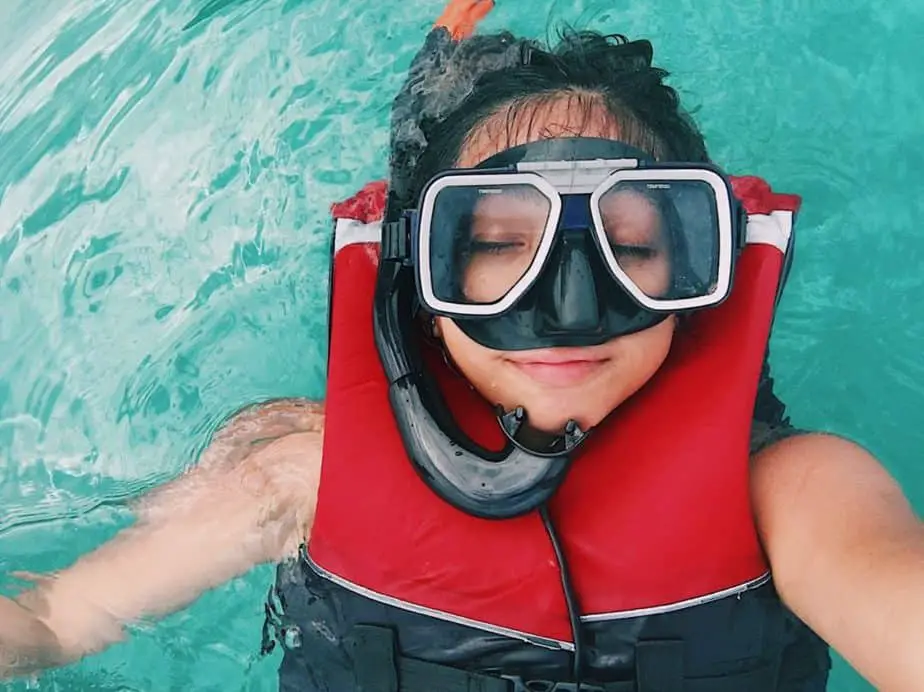
How Does Snorkeling Equipment Work?
Now that you have a rough idea of what to expect, let’s go over some basic snorkeling equipment in further detail. Even though you don’t need much equipment to get started beyond a good snorkel and mask combo, there are definitely some useful products you can use if you have the cash to spare.
There’s an endless amount of companies and products that sell snorkeling gear, and picking the right one can be daunting. However, the most important piece of snorkeling equipment is the snorkel, since that is what you will be breathing with. A bad poor quality snorkel won’t be able to keep the water out and can be downright dangerous if you cannot get enough oxygen.
When starting out, beginners often make the mistake of submerging the tip of their snorkel beneath the surface and choking on the water that comes rushing down. You cannot breathe with a snorkel if you are more than a foot beneath the surface. If you would like to breathe any deeper than that then you should consider taking up SCUBA diving instead.
Thankfully, many snorkels now have safety features to keep the water from entering the tube. They are known as dry snorkels and they automatically shut the tube opening whenever you submerge too far. If any water accidentally makes its way into the tube, the purge valve will remove the water before it reaches your mouth.
The Individual Components of Your Snorkeling Gear
In this section, we will go over what to wear on your snorkeling trip and provide recommendations for any extra items you might want to pick up.
The Mask
When shopping for a mask, make sure you get one that is specifically for snorkeling or diving. You’ve probably got a pair of swim goggles lying around that you are tempted to reuse; do NOT use swim goggles for snorkeling!
Snorkel masks are specifically designed so that you can equalize the pressure on the eyes by exhaling through the nose, as well as equalize the pressure in your ears by pinching your nose through the nose pocket and exhaling.
Additionally, the materials that snorkel masks are made of are more durable which allows it to withstand the increasing underwater pressure if you decide to do the occasional dive. Next, the silicone skirt will seal much better against your face which prevents leaking.
We’ll leave it up to you to decide on how you want your mask to look and how much you’re willing to spend. Our main priority is on quality and usability. Water pressure should almost never be an issue as long as you don’t dive too far and generally stay along the surface.
Next, to maximize your enjoyment you should find a mask that has a wide field of vision so that you can see the underwater world without restriction. Look for masks with side lenses or one continuous lens so that you will have as few obstructions as possible.
We saved the best point for last, and that is you need a mask that fits your face perfectly. The mask is absolutely useless if water gushes in. To increase the chances of the mask sealing against your face, we recommend trying out masks that have a large silicone skirt and using mask sealant if you have facial hair.
Sometimes a mask won’t fit properly if you have a small or narrow face, and in that case look for masks designed specifically for narrower faces. You might also want to consider wearing a full face mask which has become incredibly popular in recent years.
To learn more about snorkel masks, we recommend you read our guides on how to use a snorkel mask, how to defog a snorkel mask, and how to clean your snorkel mask.

How Does a Snorkel Work?
You can’t be a snorkeler without a snorkel. Snorkels attach to the side of snorkel masks and are what allows one to breathe underwater. In the case of a full-face mask, the snorkel is built into the mask so you don’t have to buy a separate snorkel.
Traditional masks and snorkels can be bought separately but are sometimes sold together as a combo. There are three types of snorkels: 1) the classic “wet” snorkels, 2) semi-dry snorkels, and 3) dry snorkels.
Wet or “J” snorkels are the most basic, and it is literally just a tube that you breathe out of. It affords you no protection against water entering unexpectedly and leads to a lot of choking.
Most snorkels nowadays are either semi-dry snorkels or dry snorkels. This means that they have at least a splash guard, and dry snorkels have a float valve as well. The float valve automatically blocks the tube opening whenever it gets submerged to prevent water from entering.
If any water manages to enter the tube, it will accumulate in the reservoir where it can be expelled with the purge valve. This design will keep you from choking on water and will significantly improve your snorkeling experience.
Another consideration is the mouthpiece of the snorkel. It is important that you find one that is comfortable to wear for an extended period of time, otherwise your lips will feel very sore before long. Lastly, the snorkel must also secure itself firmly to your mask with its mask clip.
The Wetsuit or Rash Guard
Depending on where you plan on snorkeling, a wetsuit or rashguard may not be strictly necessary. If you plan on snorkeling in a tropical location, you may not need a wetsuit for snorkeling but a rash guard can still come in handy.
Wetsuits and rash vests cover exposed skin, which provides a layer of insulation, protection, and added buoyancy. A wetsuit can come in many varieties, such as full-sleeved, sleeveless, short-sleeved, as well as full wetsuit or shorties.
Next, wetsuits are made from neoprene which not only keeps you warm but helps you stay afloat. Wetsuits come in various thicknesses, from as thin as 1mm to as thick as 10mm. You may see two numbers, such as 3/5mm or 5/6mm, and the first number refers to the thickness of the neoprene material around your limbs, and the second is the thickness around the torso.
Furthermore, wetsuits are extremely fitted to keep water out whereas rash guards will have a looser fit. Rash guards are often worn by surfers to protect their body from chafing against the board, however snorkelers can benefit from them as well.
By covering your skin with a rash guard, you can protect yourself from jellyfish stings as well as the sun’s harsh UV rays. Rash guards do not offer you much insulation or buoyancy compared to a wetsuit, but this is not an issue in warm and shallow waters.
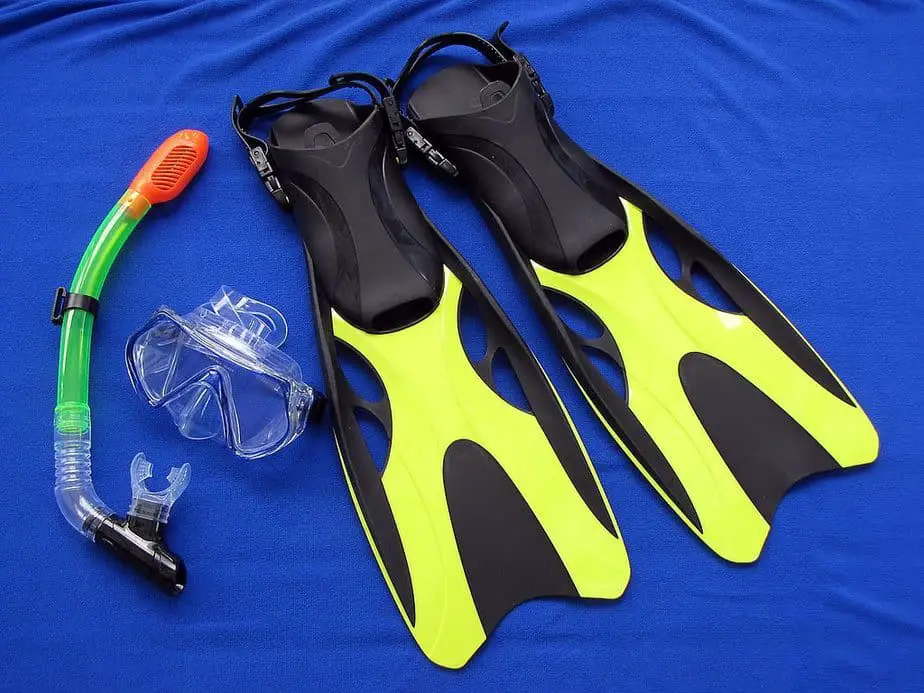
The Fins
If you want to swim like a fish in water, you need to get yourself a pair of fins! Like the other items, there are many models and types to choose from. In this section, we’re going to give you a quick overview of each.
First, consider whether you want an open-heel or closed-heel fin. This refers to the foot opening, and which one you select depends on the water temperature you plan to snorkel at. Closed-heel fins are worn barefoot and have a tighter fit. Open-heel fins have a bigger opening because they are designed to be worn with dive booties, which keep your feet warm.
Second, consider the fin length. Long fins are typically used by SCUBA divers and short fins are better suited for swimming and snorkeling. The reason for this is that long fins tend to be stiffer and generate more thrust with each kick, but they require more energy to use. Short fins tend to be more flexible and easier to kick with, but generate less thrust with each kick, though you can kick faster with them.
Short fins are excellent for people who travel often since they take up less space. Furthermore, they are easier to swim with compared to long fins and tend to feel more comfortable since they are not as stiff.
When you have your fins on, make sure you watch your step. It is very easy to trip over your fins when walking. However, walking backwards into the water with fins on will actually decrease your chances of falling.
Furthermore, when traveling to and from snorkeling locations and before you put on your fins, we recommend you wear water shoes to protect your feet from shells and other debris.
Diving Underwater with a Snorkel
Snorkeling is mostly done along the surface of the water. Snorkels aren’t very long – approximately a foot to a foot and a half in length – so you can only breathe near the surface. You might be wondering why the snorkels aren’t longer.
The reason is that the longer the snorkel, the harder it gets to breathe through it, and the harder it is to vent out all of the CO2. Unfortunately, our lungs are not very good at suction, and so snorkels are kept short so that we can safely inhale sufficient oxygen.
You might have seen people diving underwater with a snorkel, and you might be wondering how they do it. The truth is, experienced snorkelers are capable of holding their breath and conserving their oxygen by reducing any unnecessary movement. Thus, they will sometimes dive down several meters underwater to get a closer look at fish or coral.
Expect water to fill your snorkel tube when you dive down, unless you use a dry snorkel (this is not recommended because it can trap air in the tube and add unwanted buoyancy). When you resurface, you will have to forcefully exhale to blow the water out of the snorkel so that you can breathe through it again. You should get comfortable with this technique if you plan on diving often. Practice blowing water out of the snorkel in a pool before heading into deeper waters.
To help them swim faster and farther while conserving energy, snorkelers should wear fins. When swimming underwater, you should only be using your feet to move around. The more body parts you use, the faster the oxygen in your blood gets used up, and the quicker you’ll need to surface.
When diving underwater with a wetsuit, snorkelers must also use some dive weights. Remember that wetsuits are naturally buoyant, which means you will constantly be using energy to stay down. Dive weights will help neutralize the buoyancy, meaning you will no longer be floating up while underwater even with a wetsuit.
If you have a life vest on, you cannot dive while snorkeling. Snorkel vests, on the other hand, are a type of flotation device that are specifically designed to allow for diving. You can fill the vest with air when you want to stay afloat, or release all of the air so that you can freely dive. They are highly recommended for snorkelers that also want to do the occasional dive.
Until you have more experience with snorkeling, we recommend beginners stay along the water’s surface. Diving underwater introduces new challenges such as having to equalize the pressure in your mask and ears due to the increasing water pressure. Furthermore, holding your breath can lead to blackouts and drowning.
You can learn more about how to safely dive while snorkeling here.
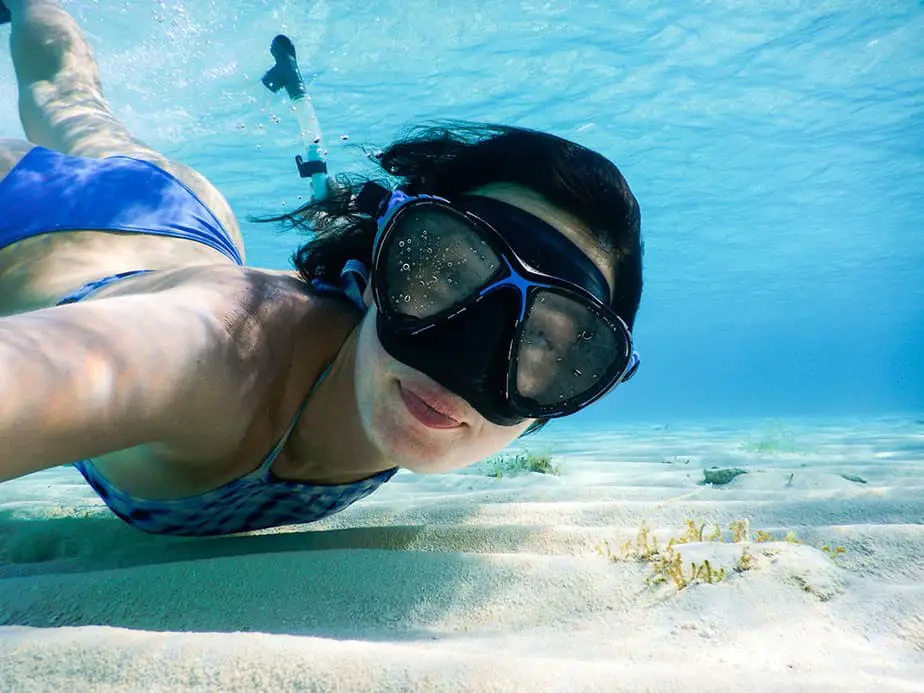
Staying Safe while Snorkeling
There are a lot of minutiae when it comes to beginner snorkeling tips and tricks you can do to stay safe in the water. However, we feel that if you know nothing else about snorkeling safety, you should at least know these three tips.
Wear a Flotation Device
Both beginners and experienced snorkelers alike should wear a flotation device such as a snorkel vest. Flotation devices are your lifeline in case of an emergency. For example, a sudden riptide may pull you far away from land, a jellyfish could sting you, or you may suffer an unexpected medical emergency.
These things could happen to anybody, even experienced snorkelers, so there’s no reason not to wear some kind of flotation device. With a buoyancy aid, your chances of survival increase and you will be thankful you are wearing one in case things go wrong. Furthermore, snorkel flotation devices help you conserve energy by helping you stay afloat.
Whereas before your time in the water would be limited by how much energy you have left, with a flotation device you could stay afloat for as long as you want. Stop cutting your snorkeling trips short and use a snorkeling aid to conserve your strength.
Common snorkeling flotation devices are snorkel vests, life vests, buoyancy belts, wetsuits, and even fins. Life jackets are the safest out of these devices because they are designed to keep your head out of water. However, that means it may get in your way when snorkeling since you’re constantly trying to put your head underwater. However, they are recommended for beginners who want maximum safety at the expense of enjoyment.
Next, snorkel vests are highly recommended for everyone else because they can be inflated and deflated while out in the water. This gives you the option to dive down when you feel like it. When you need to recover your stamina, simply inflate it and snorkel along the surface in the meantime.
Next, flotation belts that keep your body floating horizontally won’t get in the way like a left vest would. However, you cannot deflate them like a snorkel vest, so diving is out of the option. Also, make sure to avoid flotation belts that help you float vertically, as this makes it difficult to snorkel.
Lastly, wetsuits and fins have some natural buoyancy to them. This is because air bubbles are trapped in the material during the manufacturing process which causes them to float. However, do not rely on them to keep you completely afloat the way a real flotation device can.
Check the maximum weight rating of each flotation device before purchasing them. Keep in mind that only life jackets are designated by the United States Coast Guard (USCG) as a “life-saving device”, meaning it is designed to keep your head out of water and has passed multiple safety checks.
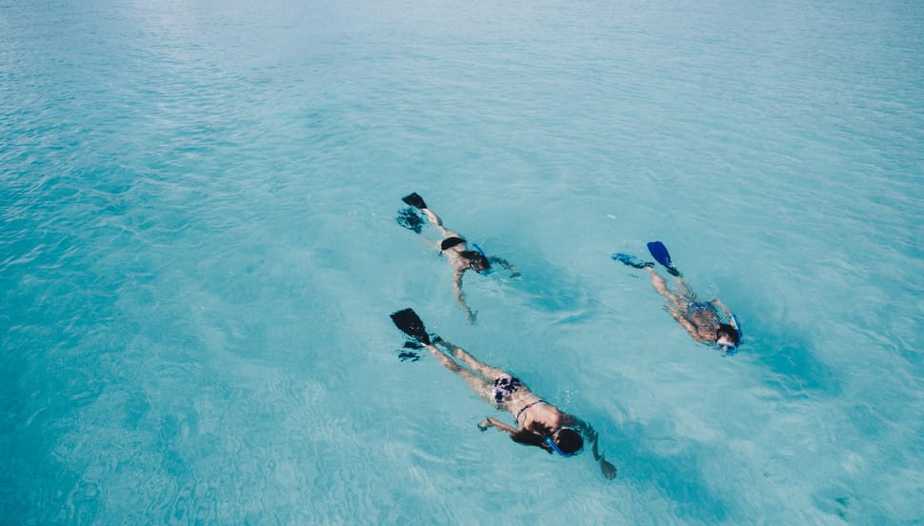
Never Snorkel Alone
Everything is more fun with a friend, and snorkeling is no exception. Try to always snorkel with a friend or family member or in a group. Ideally, your partner is a strong swimmer who can look out for you in case anything goes wrong, and vice versa. You want to keep a close eye on each other and be ready to call for help in the event of an emergency.
An easy way to snorkel with others is to go with a tour. You will be taught the basics of snorkeling from a guide and you will be with many others who can look out for each other. Furthermore, if you don’t know the location well and don’t have any equipment of your own, a tour guide will take you to a safe location and lend out the necessary gear.
Don’t Panic
When you leave the safety of the shore or boat for the first time and realize that your feet don’t touch the floor and you’re completely surrounded by water, you might feel an uncomfortable sense of panic. If you panic, you may either freeze up and sink or start flailing around and waste precious energy you need to stay afloat.
Another common cause of panic is when water enters the snorkel tube, causing you to choke. We highly recommend you use a dry snorkel, which has a valve that automatically closes the tube whenever water tries to flood in. It’s also useful for diving because you don’t have to blow out water each time.
As long as you are with a friend and are wearing a flotation device, you can easily keep your nerves in check. Practice staying afloat and staying calm when you choke on water in a safe environment. Practice makes perfect, and if you are ill-prepared when actually faced with the real thing, you are putting your life in danger.
How to Maintain Your Snorkeling Gear
Snorkeling gear that is properly maintained will last for years. However, without some basic maintenance, your snorkeling gear – particularly your wetsuit or flotation device – can develop mold or dry up and crack if you aren’t careful. Here’s how you can keep your gear in tip-top condition.
After exiting the water, make sure to thoroughly rinse your gear with fresh water. You can do a more thorough cleaning job once you’re back home, but for now just make sure there isn’t any salt or other residues on your equipment. When storing your equipment, make sure to place your snorkel, mask, and fins in separate compartments of your bag so they don’t scratch each other.
Once you’re back at the hotel, take your wet equipment out of the bag as quickly as possible so that they can fully dry. Otherwise the moisture can cause mold to grow. Leave your gear in a well-ventilated area away from the sunlight. Direct sunlight can damage your gear by causing them to become brittle and crack. Never leave your equipment out in the sun and always let them air dry in the shade.
When you’ve returned home from the trip, it’s time to thoroughly clean your gear. For your snorkel mask, scrub it using a toothbrush with toothpaste. If your mask has a plastic lens, use dish soap and scrub with a soft brush or with a soft cloth. Rinse and dry thoroughly with a towel before leaving it out to dry.
For the rest of your gear, soak them in a mixture containing 10 parts water to one part bleach. Let sit for thirty minutes so that the bleach solution kills all the bacteria and mold. Rinse thoroughly with warm water, wipe dry, and leave out to air dry.
It is imperative that you allow your gear to dry completely before storing it away, otherwise you will be in for a moldy surprise the next time you want to use them. Don’t stack too much equipment on top of each other. Fins can easily get bent and masks and snorkels can crack or get scratched up.
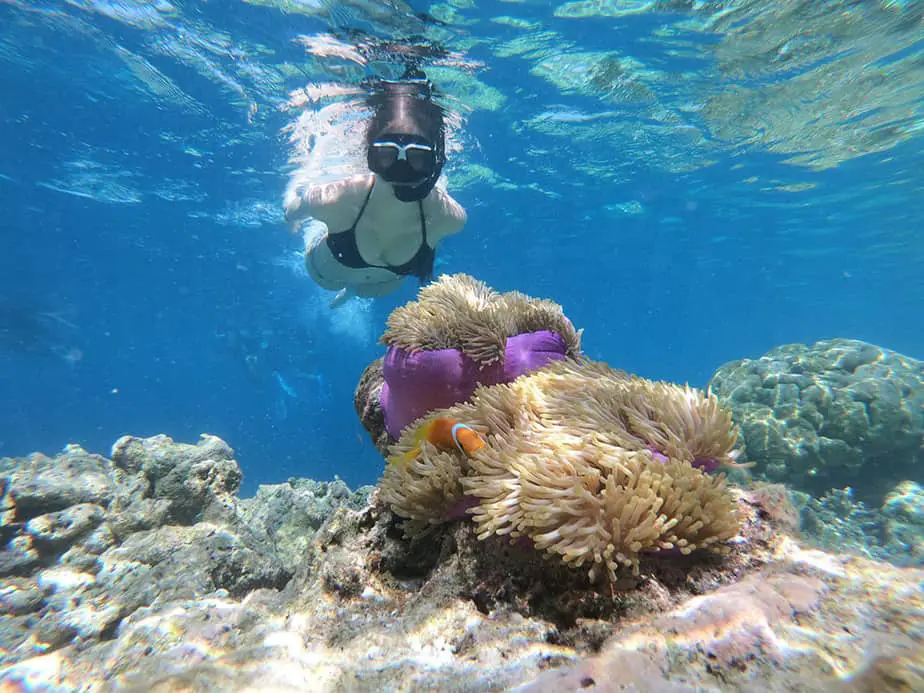
Ideal Conditions for Snorkeling
Generally speaking, the best time to snorkel is early in the morning. There are many reasons for this. To start, that is when the sun is not yet very bright and that is when the sun is producing the least amount of UV rays during the day. Around noon to early evening is when the sun is shining the greatest amount of UV radiation.
Next, the waters will be calm the earlier in the morning it is. This is good for many reasons, the most important being that it is safer, the second is that the sand will not have been kicked up by the motion of the waves yet. This means clear waters which lets you see more fish and take better photographs.
To ensure that the waters are calm, try to snorkel in a bay or a lagoon where it is naturally protected by the environment. You can also ask fellow beachgoers for advice, such as if they’ve seen any schools of fish or the condition of the water for that day.
If the whether is too windy, you might have to call off your plans to snorkel. The wind can cause waves and currents to form that can reach as high as 6-10 ft tall. Plus, wind can cause sediment to get disturbed which decreases the visibility of the water. It’s generally not recommended to snorkel when it’s windy.
Check out our article on the best weather conditions for snorkeling to learn more.
Sun Protection while Snorkeling
We covered this briefly in the section above, but the optimal time to snorkel is in the early morning when the amount of UV radiation is still relatively low. Sun protection while snorkeling is paramount, especially if you plan on snorkeling for many hours. Otherwise, you will return home from your vacation not with fond memories, but bright red skin that is peeling off and painful burning sensations.
The sun can cause skin damage and skin cancer, so be sure to use sunscreen or cover up any exposed sun. When snorkeling, the back of your body is most at risk of getting sunburnt. We recommend you wear a rash guard to cover up a large portion of your body. You can also look for swimwear with UPF-50 protection.
The UPF rating is very important, and you should look for swim wear or sunscreen with a UPF rating of at least 15. That means that it will block 94% of UVB radiation. Also look for broad spectrum sunscreen which protects your skin from UVA and UVB radiation. If you are not sure which sunscreens meet this criteria, then we recommend you pick any of the reef-safe sunscreen in this review.
You must use the appropriate items to protect your skin from the sun while snorkeling. Regular T-shirts offer nearly no sun protection. Furthermore, you may think it is okay to forgo sun protection equipment by snorkeling when it is cloudy. However, the UV radiation can actually penetrate through the clouds and still cause significant damage to your skin.
Check out our guide on snorkeling sun protection to learn more. Conversely, if you truly want to avoid worry about the sun’s UV rays, then you might be interested in snorkeling at night.
Keep Your Hands Off!
Keep your hands to yourself when snorkeling. You may be tempted to reach out and touch the fish or coral, however this is frowned upon and may even be illegal. When you reach out to touch any sea creatures, they will get scared and may even attack you. You can get bitten, stung, or even poisoned, and this can lead to an emergency in the water.
In the case of some creatures, such as sea turtles, even getting within a few feet of one may be illegal as they are an endangered species protected by law. As a general rule of thumb, keep your hands to yourself and look but don’t touch.
Additionally, coral are actually very brittle and can easily break. Beginner snorkelers who are not accustomed to swimming with fins often get too close to coral and damage coral with their fins. Did you know that even kicking up sand near the coral can harm them because the sand can partially cover up the coral and reduce the amount of sunlight it can absorb?
Keep a safe distance from all sea creatures because you may be exposing yourself to harm or causing more damage than you think.
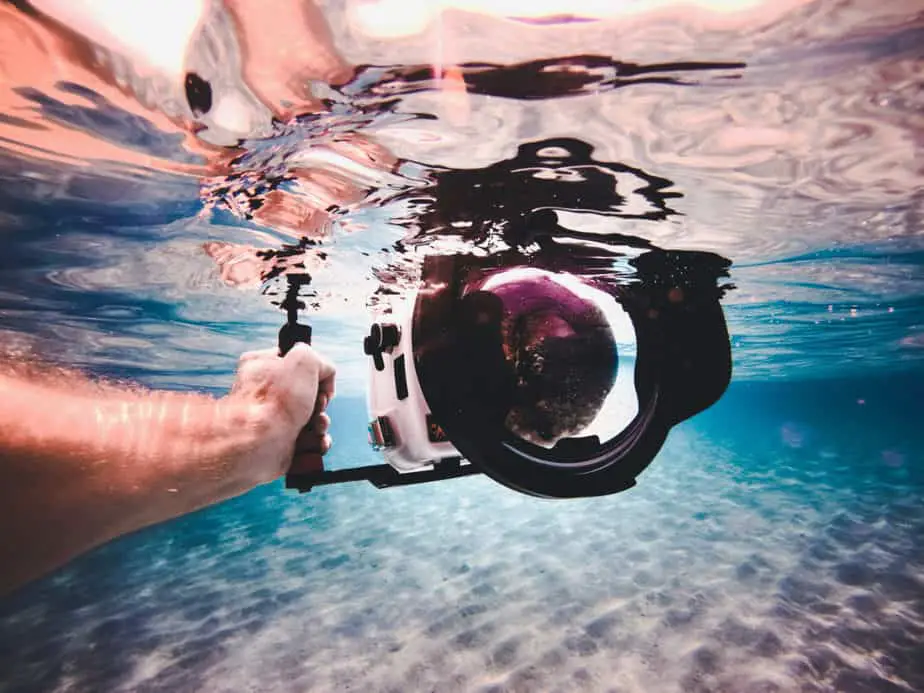
Taking Pictures While Snorkeling
As much as we’d like to say that your snorkeling experience(s) will be unforgettable, that’s simply not true. Our memories are fickle and we forget important details even when it comes to important events such as our graduation or wedding day. For the same reason why people take pictures at any important event, you should consider preserving your snorkeling adventures by taking pictures.
As snorkeling equipment advances, so too are there advancements made in affordable underwater cameras that allow you to capture all of the beautiful sights you can see in the water. Experienced snorkelers who are comfortable in the water should consider purchasing a compact underwater camera to capture and share their adventures with family and friends.
The popular options for underwater cameras are compact waterproof cameras, a DSLR with a housing case, or a GoPro. If you’re an amateur photographer, we recommend using a compact camera. They are cheap and more than capable of taking decent photos.
Anything more than this will start to get extremely expensive very quickly, as you will need to purchase not just the camera, but a whole suite of accessories and attachments and this will cost several thousands of dollars.
Furthermore, the deeper you dive the darker it gets and you should take the majority of your photographs by the surface so light won’t be an issue. Here are some quick tips to help you take better photographs underwater.
- Be Wary of the Sun: The sun is your greatest source of light and you should rely on that as much as you can rather than the built-in flash or additional lighting equipment. In shallow waters, natural sunlight is more than sufficient. A good time to take photos is at noon when the sun is directly above and distributing light evenly. You can try to shoot photos and videos at different times for more interesting compositions as well.
- Get Up Close and Personal: You have to be willing to dive down. Furthermore, there is a lot of debris and particles in the water that can get in the way of your shot. If you try to zoom in from afar, you will get a grainy photo and the subject will be difficult to see. Get as close as you can without scaring the subject off. If you notice it reacting to your presence by behaving oddly or changing colors, it may feel threatened and you should be cautious.
- Take Lots of Photos: This applies to photography in general, and snorkeling photography is no exception. You don’t have time to be checking the quality of each and every photograph while you’re out in the water. Instead, you should be taking multiple photos of each subject. Once you’re at home, you can filter out any blurry or subpar photos and keep only the good ones.
Check out our guides on how to take better pictures underwater and how to carry a camera while snorkeling for more information.
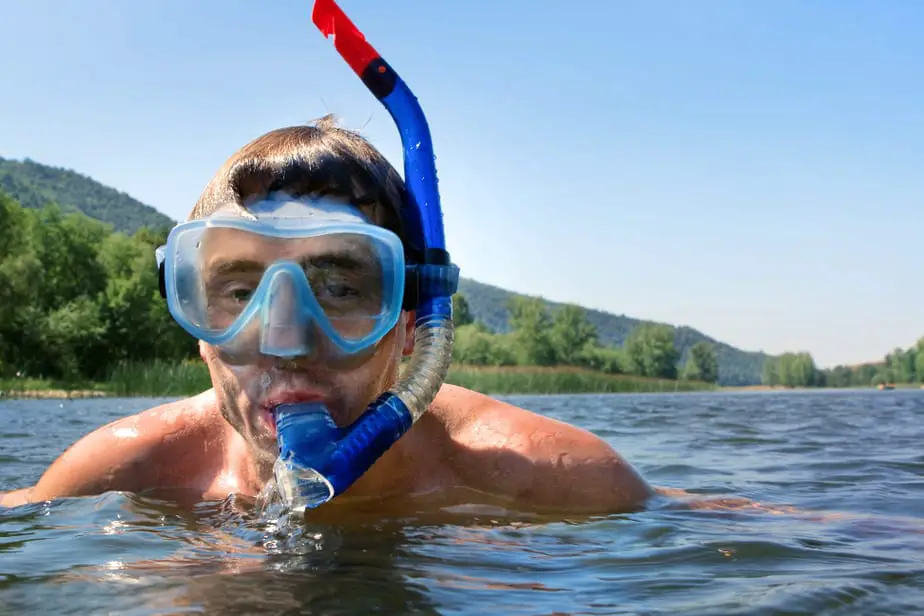
How Old Do You Have to Be to Snorkel?
Snorkeling can be done with the entire family, including young children. Perhaps you could even ignite a passion for snorkeling and the ocean in your children by teaching them to snorkel at a young age.
To start, there is no minimum age for snorkeling. There is no regulation or criteria your children must meet to start snorkeling. This freedom can be both a blessing and a curse, since it can be hard to determine when exactly your child can safely snorkel.
Based on various posts online, parents have brought children as young as two to three years old with them on their snorkeling trips. It should be a given that your children must be proficient at swimming and must be comfortable in the water.
Additionally, your children must be supervised at all times and they should wear a flotation device. You must also make sure that their equipment fits them properly and that they know how to use the snorkel and mask.
It can be a little tricky getting swim gear that fits young children, but some popular snorkels and masks have a kids-sized version that you can get. Bring your kids to a protected snorkeling area, such as a bay or lagoon, to keep them safe from turbulent waves.
Overall, there is no minimum age for snorkeling, and you can bring your children snorkeling at your discretion. Make sure you teach them the basic snorkeling etiquette and what to do in case of an emergency. Having a life vest is a must. Never take your eyes off your children, even for a few seconds.
But remember to also have a good time as a family. You can have some truly unforgettable family moments while snorkeling with your kids.
Parting Words
Hopefully the answer to the question “how does snorkeling work” is a bit more clear for you. Despite how long this article is, snorkeling is actually a pretty straightforward activity and most of the skills can be easily picked up. Your first snorkeling experience may not be the greatest, however with practice you can be proficient in no time.
As long as you have the right snorkeling equipment, select a relaxing snorkeling location, and bring a buddy along, you’ll find it to be a very laid-back and enjoyable experience. If you don’t have anybody to snorkel with, or want an experienced snorkeler to take you under their wing, the easiest way is to join a snorkeling tour.
Tours are a convenient way to learn the basics of snorkeling with a group of people in a safe environment. The tour guide will bring you to beautiful locations where the water is shallow and calm, the sea creatures are abundant, and they will provide you with a flotation device to help you stay afloat. You can ask them questions and let them know that it’s your first time snorkeling so that they can keep an eye out for you.
As you get more experience with snorkeling, you can be a bit more adventurous and do the occasional breath-hold dive. Observing the underwater creatures from afar and getting up close and personal makes a big difference. In our opinion, you haven’t truly snorkeled if you’ve never dived down. With a compact underwater camera, you can even take a few selfies with the fishes!
To conclude, it’s amazing how breathing through a tube while underwater can evolve into such a popular and fun activity. While you may not be able to explore the oceans to the extent of a SCUBA diver, you also don’t need to get a certification or very much equipment either. As long as you know how to swim and have a mask with a snorkel attached to it, you can have a great time snorkeling. And this simplicity is what makes snorkeling so amazing.
You might also be interested in our articles on how a snorkel works and how does a snorkel mask work.
